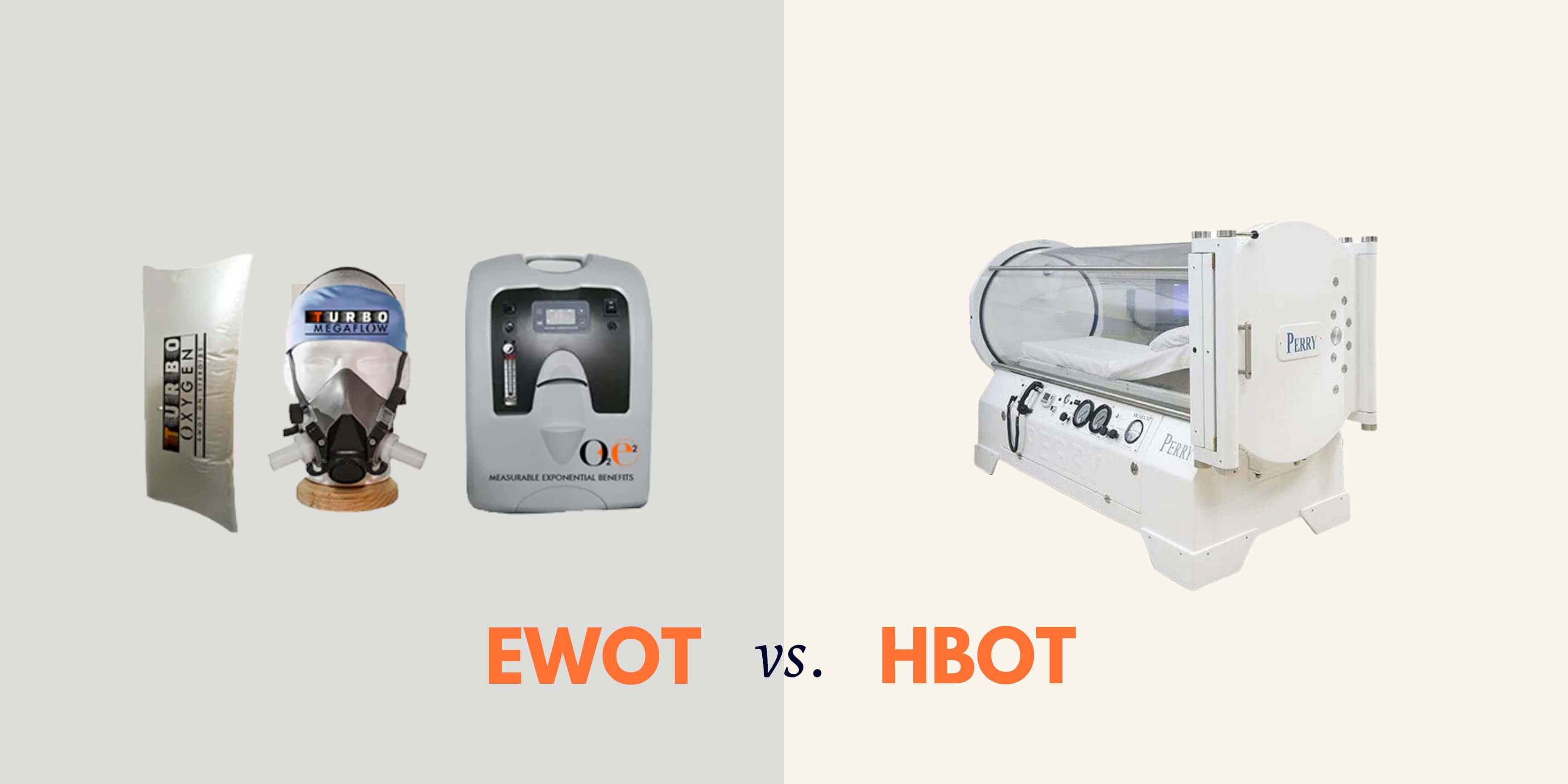EWOT versus TOHB
EWOT versus TOHB
¿Está confundido acerca de la diferencia entre EWOT y TOHB? Lea el artículo que compara las dos terapias, explora sus beneficios y le ayuda a decidir cuál es la adecuada para usted.

No hace falta decir que el oxígeno es el componente más influyente en la mayoría de las formas de vida en la Tierra. La discrepancia en el suministro de oxígeno puede desempeñar un papel importante en la intensificación del deterioro de las funciones corporales. La mejor parte es que lo contrario también es cierto.
Si bien la privación persistente de oxígeno es perjudicial para el cuerpo, la exposición controlada a un suministro excesivo de oxígeno (hiperoxia) puede rejuvenecerlo para lograr beneficios físicos y cognitivos. Se ha investigado ampliamente el impacto de un mayor suministro de oxígeno en diversos factores como el envejecimiento, el rendimiento deportivo, la recuperación, etc.
Pero a menudo nos preguntamos si el ejercicio con oxigenoterapia (EWOT) puede proporcionar beneficios similares a los de la oxigenoterapia hiperbárica (TOHB) y qué terapia es más adecuada para las necesidades individuales. Es importante tener en cuenta que el oxígeno, en todas sus formas, puede ser beneficioso para el cuerpo, y tanto EWOT como TOHB ofrecen ventajas potenciales. Antes de profundizar en la comparación, primero comprendamos qué implica cada terapia y cómo funciona.
EWOT es un enfoque dinámico que aumenta rápidamente la circulación de oxígeno en todo el cuerpo. Por el contrario, TOHB es un método terapéutico pasivo en el que el cuerpo se expone al oxígeno a mayor presión para impulsar el oxígeno hacia los tejidos.
Una ventaja clave de EWOT es que superoxigena el plasma, impulsando el oxígeno más profundamente hacia los tejidos hipóxicos distales. Es más, EWOT aprovecha la combinación sinérgica de oxígeno y ejercicio, suministrando la misma cantidad de oxígeno que HBOT en menos del 20% del tiempo.
Terapia de oxígeno hiperbárico (TOHB)
La Sociedad Médica Submarina e Hiperbárica (UHMS) define la Terapia de Oxígeno Hiperbárico como " una intervención en la que un individuo respira cerca del 100% de oxígeno de forma intermitente mientras está dentro de una cámara hiperbárica que está presurizada a una presión superior a la del nivel del mar (1 atmósfera absoluta o ATA) ". .
TOHB implica inhalar oxígeno 100% puro en una cámara presurizada especialmente diseñada. La presión del aire dentro de la cámara aumenta a un nivel más alto (2-3 veces) en comparación con la presión atmosférica normal. Esta presión de aire elevada en la cámara puede transportar oxígeno a todos los fluidos corporales , incluido el plasma, el sistema linfático, el líquido cefalorraquídeo del sistema nervioso central y los líquidos sinoviales de los huesos.
Esta terapia ayuda a los pulmones a acumular más oxígeno del que se podría lograr inhalando oxígeno puro a presión normal. Transportar este oxígeno adicional a los tejidos y otros órganos ayuda al cuerpo a combatir diversas infecciones y promueve la curación. TOHB, una forma estacionaria de oxigenoterapia, se basa en una paradoja hiperóxica-hipóxica . La UHMS ha aceptado oficialmente TOHB para tratar las siguientes afecciones.
-
Gangrena gaseosa
-
Anemia severa
Las cámaras TOHB son de dos tipos:
Cámaras de oxígeno hiperbárico de lados blandos
También conocidas como TOHB suave, las cámaras hiperbáricas blandas son bolsas inflables portátiles hechas de poliuretano termoplástico (TPU) y con un límite de presión de 1,3 ATA. Como experimentamos una presión de 1,0 ATA al nivel del mar, el TOHB suave ofrece una presión un 30% más alta que al nivel del mar. Estas cámaras están aprobadas para uso doméstico y se pueden comprar con receta médica. Los precios de las cámaras varían en el rango de $4000-$10000.
Cámaras de oxígeno hiperbárico duro
Las cámaras de oxígeno hiperbárico duro son dispositivos de grado médico aprobados por la FDA que ofrecen grandes beneficios en comparación con las cámaras blandas. Estas cámaras, fabricadas en acero o acrílico, funcionan exponiendo oxígeno 100% puro a una presión típica de 2,4 ATA y pueden alcanzar hasta 3,0 ATA. Su uso requiere prescripción médica y debe ser supervisado por profesionales capacitados. Normalmente, una sesión dura 90 minutos y cuesta entre 250 y 750 dólares.

Acelere el bienestar, la resistencia física y la claridad mental
Obtenga su sistema Turbo Oxygen, el sistema EWOT definitivo en acondicionamiento corporal y autocuración.
Ejercicio con oxigenoterapia (EWOT)
Ahora, hablemos de EWOT.
El ejercicio con oxigenoterapia, como su nombre indica, es un método basado en el ejercicio para inhalar aire enriquecido con oxígeno mientras se hace ejercicio. EWOT utiliza la hiperoxia como elemento fundamental del marco. En pocas palabras, EWOT implica respirar entre un 90% y un 96% de oxígeno puro mientras se hace ejercicio. EWOT ayuda a su corazón a bombear oxígeno disuelto en plasma hacia los pequeños capilares y posteriormente a las células, llegando a regiones inflamatorias con circulación inadecuada.
Como resultado, las células están saturadas con suficiente oxígeno, nutrientes esenciales y elementos antiinflamatorios vitales para controlar la inflamación. Las características más importantes de EWOT son el suministro de oxígeno bien dirigido, cuantificado y con un tiempo determinado a través de las fosas nasales.
Esta combinación de ejercicio y oxígeno hace su magia al mejorar su energía, resistencia, recuperación y todo eso, ¡eso también en solo 15 minutos!
El Turbo Oxygen System, la entidad basada en EWOT más asequible, le ayuda a obtener los máximos beneficios de su rutina de ejercicios.
La ciencia detrás del EWOT
Cuando haces ejercicio, tus músculos exigen más alimento y energía. Básicamente, el ejercicio es la creación de demanda. Para hacer frente a esta necesidad adicional de oxígeno , la frecuencia respiratoria debe aumentar de 15 respiraciones por minuto a 40-60 respiraciones por minuto, lo que representa ~100 litros de aire.
La incorporación de oxígeno a su rutina diaria de ejercicios puede llevar oxígeno al plasma sanguíneo, superoxigenando los tejidos del cuerpo. EWOT le permite ser más eficiente en la absorción de oxígeno y en el suministro de oxígeno al tejido de trabajo.
EWOT es similar a TOHB duro, pero en lugar de usar una cámara presurizada, su corazón ejerce presión para impulsar oxígeno hacia los tejidos hipóxicos distales. A medida que los vasos sanguíneos se dilatan durante el ejercicio, la sangre puede llegar más profundamente a los tejidos, reduciendo el tiempo necesario para experimentar los beneficios exponenciales.
Una sesión EWOT de 15 minutos con Turbo Oxygen System ofrece casi la misma cantidad de oxígeno que obtendría en una sesión de 90 minutos en una cámara dura TOHB. En términos simples, está recibiendo los beneficios sinérgicos de un ejercicio cardiovascular de 15 minutos junto con los beneficios potenciales de superoxigenar la sangre, el plasma y los tejidos en una sexta parte del tiempo.
Similitudes entre EWOT y TOHB
¿Alguna vez has pensado en las similitudes que comparten EWOT y TOHB?
La oxigenoterapia hiperbárica y el ejercicio con oxigenoterapia son conceptos que se derivan de una hipótesis: regular el suministro de oxígeno al cuerpo es la base de la vida y la energía.
Ambas técnicas utilizan la hiperoxia como bloque básico de su sistema. La inhalación del exceso de oxígeno es el factor clave, y este oxígeno adicional se entrega al cuerpo para mejorar la absorción de oxígeno en los tejidos.
Distinciones entre EWOT y TOHB
-
Presión constante frente a presión parcial: TOHB utiliza alta presión en las cámaras para mejorar la absorción de oxígeno, mientras que EWOT utiliza el potencial de la combinación de un alto suministro de oxígeno al torrente sanguíneo junto con la presión parcial del ejercicio en el cuerpo para impulsar el oxígeno al sistema.
Comparación en pocas palabras
| Parámetro | TOHB | EWOT |
|---|---|---|
| Forma estacionaria vs ejercicio | Forma estacionaria de oxigenoterapia. | Utiliza el ejercicio como parte del proceso. |
| Factor clave | Paradoja de hiperoxia-hipoxia | Ejercicio |
| Presión constante versus presión parcial | El usuario se acuesta en una cámara que contiene oxígeno a mayor presión para mejorar la oxigenación del cuerpo. | Integra un mayor suministro de oxígeno con la presión parcial del ejercicio. |
| Eficiencia de tiempo | Menor eficiencia del tiempo Se necesita más tiempo para saturar los tejidos con oxígeno ya que el proceso depende completamente de la presión. |
Mayor eficiencia del tiempo Muestra resultados rápidos a medida que el cuerpo absorbe más oxígeno en un lapso más corto. |
| Rentabilidad | Exorbitantemente caro en comparación con las terapias basadas en ejercicios debido a su mayor coste operativo y menor eficiencia de tiempo. | Sirve como una opción económica ya que el proceso utiliza dispositivos elementales como concentradores de oxígeno y máscaras. |
| Requisito de prescripción | TOHB requiere receta médica | EWOT no necesita receta médica |
| Compatibilidad con el ejercicio | No propicio para el ejercicio. | Ideal para hacer ejercicio |
| Duración de la sesión | 1-2 horas | 15 minutos |
La comida para llevar
Al final del día, EWOT y TOHB ofrecen muchos beneficios similares.
TOHB sirve como una mejor opción para las personas que tienen algún tipo de problema físico, enfermedad o heridas que no cicatrizan [6] que les impide poder hacer ejercicio con la intensidad que necesitan para atraer oxígeno a su cuerpo. El contacto directo de la piel con altas concentraciones de oxígeno es muy beneficioso y existen muchos usos aprobados por la FDA [7] en los que TOHB ha demostrado grandes beneficios.
De la comparación, queda claro que la oxigenoterapia basada en ejercicios es más efectiva y eficiente que la oxigenoterapia hiperbárica en términos de mejoras generales de salud y bienestar.
En comparación con EWOT, TOHB es mucho menos factible porque se queda atrás en los distintos parámetros de rendimiento y es más costoso.
Creemos que si puede hacer ejercicio, los beneficios que ofrece EWOT superarán los beneficios de TOHB porque es algo que puede incorporarse fácilmente a su rutina diaria.
Encontrar sólo 15 minutos diarios para hacer ejercicio con oxígeno puede hacer maravillas por usted.
Teniendo en cuenta los marcos de terapia basados en ejercicios, el Turbo Oxygen System es el mejor del grupo, con su inmenso potencial para una curación profunda y una mejora energética.
En términos simples, EWOT supera a HBOT en viabilidad y rentabilidad; después de todo, seguirá con el enfoque que más le beneficie.

Artículos sobre respiración y oxígeno
-
Respiración
-
Oxígeno
- El moho podría estar en su hogar ahora mismo. ¿Estás en riesgo?
- Venza el estrés laboral de la manera correcta
- El mal aliento causa asma: ¡esto es lo que debe hacer!
- Respiración óptima, autismo y desarrollo cerebral
- ¿Por qué respirar mejor? El mal aliento te enferma o te enferma aún más. Aprenda a respirar mejor ahora
- Cura tus problemas respiratorios con ejercicios de respiración
Conozca y trabaje con nuestros profesionales
Obtenga ayuda personal para mejorar su salud
y vitalidad.
Obtenga entrenamiento y orientación expertos de nuestros expertos en Respiración Óptima.
Si buscas contar con un experto en Respiración Integral, Voice Coach
o alguien que se especialice en ansiedad o depresión, no busque más.




